From the U.S. Fish and Wildlife Service Midwest Region:
This northern flicker is ready for its close up! Watch for flickers in open woodlands, fields with scattered trees and forest edges.
Photo: Northern flicker courtesy of Rick Cameron/Creative Commons.
Protecting natural resources, including air, land and water. Also of interest are threatened and endangered species as well as endangered species. Conservation (wildlife, soil, water, etc.) issues also discussed. Topics include: RCRA, CERCLA, Clean Water Act (CWA), NEPA, 404 Permits, EPCRA, FIFRA, and others.
Search This Blog
Sunday, May 31, 2015
Friday, May 29, 2015
Union Pacific Publishes Sustainability and Citizenship Report, Featuring Redesigned Online Version with Enhanced Visuals
From Union Pacific:
Union Pacific Publishes Sustainability and Citizenship Report, Featuring Redesigned Online Version with Enhanced Visuals
OMAHA, NEB., MAY 29, 2015
Union Pacific's 2014 Sustainability and Citizenship Report, including a redesigned online version, recounts the company's evolving approach to operating safely, strengthening communities, engaging employees and preserving the environment. The sixth annual report also announces the company's new fuel consumption and associated greenhouse gas emissions reduction goal.
"Through our annual Sustainability and Citizenship Report, we share Union Pacific's commitment to sustainable business practices and responsibilities as a corporate neighbor," said Bob Turner, Union Pacific senior vice president-Corporate Relations. "We are pleased to provide a refreshed online format as another channel to connect with the people, businesses and communities with whom our operations intersect."
Report highlights include:
- Achieving a company-best annual reportable personal injury rate and decreasing reportable derailments by 7 percent year over year.
- Hiring more than 1,700 military veterans, representing 28 percent of new employees, up from 24.6 percent in 2013.
- Conducting more than 4.8 million miles of visual track inspections and 222,000 miles of electronic track inspections to prevent derailments.
- Increasing spending with diverse suppliers by about 5 percent compared with 2013.
- Nurturing a diverse high-quality workforce through Employee Resource Groups and robust career development programs.
- Helping customers eliminate an estimated 35.8 million metric tons of greenhouse gases by choosing rail over truck transportation.
- Completing 45 utility conservation projects, saving the energy equivalent to that consumed by more than 260 U.S. homes annually.
For more information on these initiatives and an overview of Union Pacific's goals as they relate to meeting the nation's dynamic and growing freight transportation needs, view the report at www.up.com.
About Union Pacific
Union Pacific Railroad is the principal operating company of Union Pacific Corporation (NYSE: UNP). One of America's most recognized companies, Union Pacific Railroad connects 23 states in the western two-thirds of the country by rail, providing a critical link in the global supply chain. From 2005-2014, Union Pacific invested more than $31 billion in its network and operations to support America's transportation infrastructure. The railroad's diversified business mix includes Agricultural Products, Automotive, Chemicals, Coal, Industrial Products and Intermodal. Union Pacific serves many of the fastest-growing U.S. population centers, operates from all major West Coast and Gulf Coast ports to eastern gateways, connects with Canada's rail systems and is the only railroad serving all six major Mexico gateways. Union Pacific provides value to its roughly 10,000 customers by delivering products in a safe, reliable, fuel-efficient and environmentally responsible manner.
The statements and information contained in the news releases provided by Union Pacific speak only as of the date issued. Such information by its nature may become outdated, and investors should not assume that the statements and information contained in Union Pacific's news releases remain current after the date issued. Union Pacific makes no commitment, and disclaims any duty, to update any of this information.
Streamlined Process Helps Farmers Put Conservation on the Ground in Record Time
From the #USDA:
Posted by Ed Biggers and T.J. Wilson, Natural Resources Conservation Service, on May 29, 2015 at 3:00 PM
The USDA Natural Resources Conservation Service (NRCS), is always looking for ways to do things better — whether it is how to conserve more soil on a farming operation or how to streamline internal business processes.
Recently, NRCS made vast improvements to its grants and agreements process making it easier, more timely and efficient for partners to work with us on locally-led conservation projects.
Through the Secretary of Agriculture’s Signature Process Improvement Initiative, NRCS was given strategic direction to improve its grant and agreement process. NRCS not only rose to the challenge, the agency exceeded the projected 20 percent improvement goal by reducing the time needed to develop and award grant and agreement requests by 85 percent. Additionally, the new process resulted an 80 percent decrease in missing or incorrect information on grants and agreements.
Previously, a partner would wait an average of 60 days, from start to finish, before an agreement was finalized. Now, that same customer only has to wait nine days.
Streamlining this process gets conservation on the ground more quickly and uses the time of federal employees more efficiently. In the end, it’s a win for partners, agricultural producers and the local communities that benefit from the conservation projects they support.
These solutions are part of the Blueprint for Stronger Service, USDA’s proactive effort to reduce spending, streamline operations and cut costs. By stepping back and reconsidering our processes, we can save time, money and benefit many — from producers to employees to partners to taxpayers. And, we won’t stop here.
Related Posts
USDA Goes All in for Produce Safety Outreach
From the #USDA:
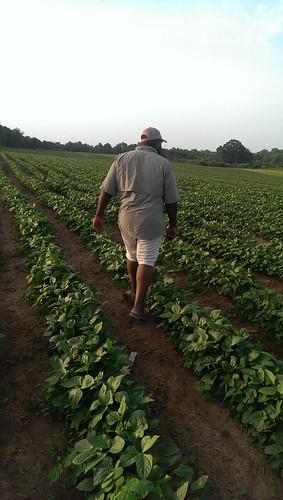
Posted by Lorenzo A. Tribbett, AMS Fruit and Vegetable Program Specialty Crops Inspection Division Director, on May 29, 2015 at 2:00 PM

The Harmonized GAPs Food Safety audit provided by AMS has helped small grower Warren Ford expand his business from selling a couple hundred bushels of peas a summer to selling more than 3,000 cases a summer to Walmart. Photo courtesy Warren and Rosha Ford.
For the produce industry, the summer and fall of 2015 is more than a chance to share a new season of crops with customers. It’s when several of the Food and Drug Administration (FDA) Food Safety Modernization Act (FSMA) laws will become final. FSMA will make significant changes to the country’s food safety laws, including the first-ever regulation of fresh produce and a more proactive approach to preventing foodborne illnesses. My colleagues at the USDA’s Agricultural Marketing Service (AMS) have been working hard with our partners to expand our outreach efforts about food safety to help the produce industry prepare for compliance.
One of the ways that we help the industry prepare for compliance is through a successful partnership with Cornell University and the FDA via the Produce Safety Alliance (PSA). We recently renewed this partnership through a Cooperative Agreement that enables the three entities to devote funds for training and outreach events. Since 2010, AMS has enjoyed working with our colleagues to engage with produce growers, industry members, regulators, and extension educators through working committees, public meetings, focus groups, and webinars.
A major reason for our partnership with FDA and Cornell University is the ability of the AMS Good Agricultural Practices (GAPs) Audit Program to help produce businesses meet many FSMA requirements. As an independent third-party, this program, offered by our Specialty Crops Inspection (SCI) Division, verifies that operations are following industry-recognized food safety practices and recommendations from FDA.
For example, our Harmonized GAPs Food Safety audits helped a group of small growers in the Small Farmers Agricultural Cooperative meet Walmart’s food safety requirements. SCI employees worked with Tuskegee University to help the Alabama growers understand the audit’s requirements, setting them up to successfully supply the country’s largest retailer.
“Almost everybody you sell to wants to know that you are GAP certified,” said small grower Warren Ford. “Successfully completing the Harmonized GAPs Food Safety audit has done wonders for our business. After 3 years of GAP certifications, we have expanded our business from selling a couple hundred bushels of peas a summer to selling more than 3,000 cases a summer.”
This effort is a yet another example of one of the many ways USDA is creating opportunities in our nation’s rural communities. Through the StrikeForce Initiative, the department has invested $16 billion to support rural communities experiencing persistent poverty. As a result, department resources and outreach efforts have yielded success stories all over the country.
All of us here in the department are doing our best to create more success stories for the produce industry. Recently, our sister agency – the National Institute of Food and Agriculture (NIFA) – announced the availability of funds for food safety training, outreach, and technical assistance to support FSMA compliance. In June, the PSA will launch it national training programs with two Train-The-Trainer courses where participants can become certified to deliver the PSA Grower Training Course that was designed to help growers meet the proposed training requirement in the FSMA Produce Safety Rule.
Everyone in the produce industry needs to do whatever they can to prepare for FSMA. We encourage you to sign up for updates from the FDA, inquire about our SCI Division, and join the PSA list serve. USDA is all in for the team effort to prepare for FSMA. We need you on our team.
Related Posts
Key Sage Grouse Habitat Protected in Colorado through a Conservation Easement Partnership
From the #USDA:
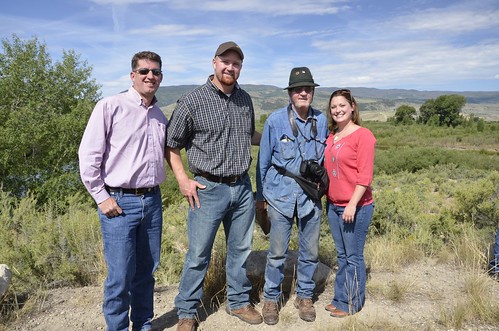
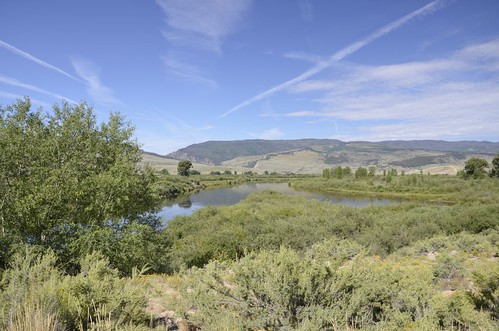
Posted by Petra Barnes, Natural Resources Conservation Service, Colorado, on May 29, 2015 at 1:00 PM

Chris West (who directed CCALT up until May 2015), left, celebrates conservation progress at the Yust ranch with Jay and Jim Yust, and CCALT's Carolyn Aspelin, who worked closely with the family to close this important conservation easement. Photo courtesy of Deborah Richie with SGI.
The recent conservation easement on the Yust Ranch in northwestern Colorado represents not only the preservation of a five-generation ranching entity, it also illustrates the vitality of partnerships that expand federal programs and initiatives aimed at protecting wildlife habitat, particularly for species of concern.
The Yust family partnered with USDA’s Natural Resources Conservation Service (NRCS) and Colorado Cattlemen’s Agricultural Land Trust (CCAT) to enroll 955 acres of land near the confluence of the Blue and Colorado rivers into a perpetual easement, held by CCALT. NRCS contributed $715,000 through the NRCS-led Sage Grouse Initiative (SGI) and the former Farm and Ranch Land Program (FRPP). The 2014 Farm Bill merged FRPP with other easement programs to form the new Agricultural Conservation Easement Program (ACEP).
“Securing this easement was a priority for the agency,” said Clint Evans, NRCS state conservationist in Colorado. “The property encompasses prime sagebrush-steppe, which is habitat for the greater sage-grouse.”
The U.S. Fish and Wildlife Service designated greater sage-grouse as a candidate for listing under the Endangered Species Act, spurring NRCS to accelerate conservation efforts to restore and protect habitat for bird. Optimal habitat for greater sage-grouse is also good for ranching, resulting in a win-win situation.
The Yust family has been on the ranch since 1884, and the family partnered to protect it for the long term. A conservation easement offered the ideal solution. SGI aims to conserve intact and thriving sage grouse habitat while providing matching funds to help purchase development rights and ensure lasting and productive ranchlands.
“Conservation easements are significant in Colorado, especially in the northwest portion of the state,” said Dawn Jackson, NRCS assistant state conservationist in Colorado. “NRCS contributed to almost 70 easements in that area. This, only the second easement of its kind in Grand County, represents the introduction and expansion of protection for the sage grouse in targeted areas.”
NRCS’ commitment to protecting wildlife habitat has resulted in an investment of more than $23 million between 2010 and 2014 to purchase easements in Colorado alone. Through SGI, more than 1,200 ranchers in 11 Western states have enhanced more than 4.4 million acres of habitat for sage grouse through easements and other conservation improvements.
Learn more about NRCS’ sage grouse conservation efforts.

The Yust ranch in Colorado harbors both important sage grouse habitat in the sagebrush uplands and sections of the Colorado and Blue Rivers, important for trout, recreation, and other wildlife. Photo courtesy of Deborah Richie with SGI.
Related Posts
Managing for Wildfires Every Single Day of the Year
From the #USDA:
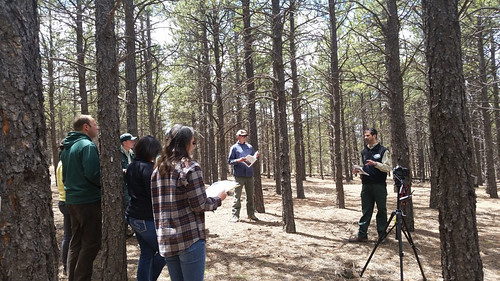
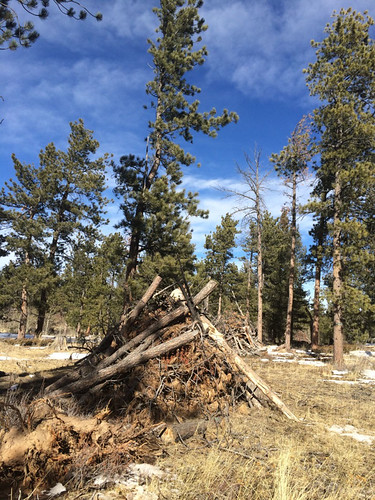
Posted by Carita Chan, U.S. Forest Service Research & Development, on May 29, 2015 at 11:00 AM

Research Forester Mike Battaglia leads a field tour at the Manitou Experimental Forest, in Colorado, describing research aimed at understanding how different tree densities influence growth rates and subsequent re-entry, in order to maintain longevity of restoration treatments. Photo credit: US Forest Service
On June 9, 2012, a lightning strike sparked a wildfire in the mountains west of Fort Collins, Colorado, burning into the Roosevelt National Forest. The High Park fire burned over 87,000 acres and remains the third largest fire in recorded Colorado history, with more than 250 homes destroyed.
Matt Champa, assistant prescribed fire specialist with the Canyon Lakes Ranger District of the Arapaho and Roosevelt National Forests, remembers clearly the two and a half weeks the High Park Fire burned. Matt was among the individuals actively working on the ground to suppress and contain the fire; at its height, more than 2,000 people were involved in the suppression effort.
Although Matt serves as a firefighter when needed during fire season, he and his team work year-round to restore fire-adapted ecosystems and to help reduce the risk of extreme wildfires in the future. Prescribed fire, or controlled burns, is the careful planning and application of fire to promote healthy forests, for instance reducing the amount of hazardous fuels and encouraging the growth of native plant species. These activities recognize the important ecological role of wildfire in these ecosystems.
But when you’re faced with over 650,000 acres of national forest land, as Matt is with the Canyon Lakes Ranger District, how do you decide which areas should be treated? I had the opportunity to shadow Matt as he surveyed fuel treatment projects on the Roosevelt National Forest and gained insight into this work. The main takeaway, Matt emphasized, is that this is a team effort. A suite of specialists, including geospatial planners, wildlife biologists, hydrologists, and timber professionals, work together to identify sites for treatment in a process that is strongly grounded in science. Perhaps most importantly, this work is done collaboratively with local communities through a public scoping process. To maximize effectiveness, the team tries to focus its efforts where communities are doing complementary work.
It is also important to recognize the long timescale of these projects – fully completing a fuel treatment takes an average of ten years from start to finish. Although this seems long in terms of human time scales, it is quite short for these ponderosa and lodgepole forests, where trees can grow for hundreds of years.
Scientists with Forest Service Research & Development support land managers like Matt by conducting cutting-edge research to help make fire and fuel management more effective, safe and ecologically appropriate. At the Rocky Mountain Research Station, scientists use case studies, field research and simulation models to better understand fire regimes and the ecological impacts of management activities and to develop management techniques that incorporate the patterns and processes that result from natural disturbances.
For example, Research Forester Mike Battaglia and other collaborators work directly with Forest Service land managers to address questions and concerns about ponderosa pine restoration on the Colorado Front Range, which is part of the Collaborative Forest Landscape Restoration Program (CFRLP). Their research is helping provide land managers with guidelines for their restoration work.
“In the early stages of fuels reduction management in ponderosa pine forests, there was an urgency to reduce forest density without considering how the trees were spatially distributed within the stand and on the landscape,” said Battaglia. “However, we now know that much of our ponderosa pine forests consisted of small tree groups, with small and large openings, and individual trees distributed across the stand.”
Using sophisticated fire behavior models, they are investigating how these complex forests historically burned to determine structures that will meet fuel hazard reduction objectives while maintaining forest structures that provide other ecological benefits. Information from these studies is intended to inform future management activities.
Matt has worked for over a decade in this area, and his connection to and knowledge of the land run deep. Matt inspired me with the passion he has for his work and his dedication to the communities that he serves. The highlight of our day together was when he showed me where a completed fuel treatment curbed the spread of the High Park Fire along the edge of the Cache la Poudre Wilderness. The difference that an effective fuel treatment project can make is clearly demonstrated here; where one side of the site is comprised of charred tree remains and the other of healthy trees.
This post is part of a series featuring the Forest Service’s work on restoration across the country.

A pile of hazardous fuels, prepared for burning. Photo credit: US Forest Service
Related Posts
Surf's High for a Desert Plant
From the #USDA:


Posted by Kim Kaplan, Public Affairs Specialist, ARS Information Staff, on May 29, 2015 at 10:00 AM

Guayule is a desert shrub. USDA-ARS photo.
When you hear “surf’s up,” the last thing you might think of is a desert shrub called “guayule” (pronounced “why-oo-lee”). But technology that began with a partnership between USDA’s Agricultural Research Service (ARS) and a small Arizona-based company, Yulex Corporation, recently put wetsuits made with this daisy relative on the market that are more elastic and more comfortable than those made with conventional, petroleum-based neoprene.
The wetsuits were created with Yulex’s guayule natural rubber by Patagonia, a high-end outdoor clothing company, which currently produces and sells the wetsuits. They are also available from other retailers. The wetsuit—with its 60/40 guayule and petroleum-based neoprene blend—is proving to be popular. Surfer Magazine said: “It’s the cashmere of wetsuit material.”
But what guayule really represents is an opportunity for a home-grown source of natural rubber.
Americans have been looking for a native replacement for rubber for decades. Guayule’s potential to be this substitute has been known for nearly 100 years, but producing guayule rubber has never quite been commercially viable.
Then, in 1996, ARS patented a better method for extracting guayule’s latex from the plant cells, licensed it to Yulex in 2000, and then continued to work with the company in hopes of making guayule work commercially as a rubber source.
Yulex opened its bio-refinery for processing guayule in Chandler, AZ, in 2011-2012 and began to scale up guayule rubber extraction. The first commercial product—Patagonia’s guayule blend wetsuit—hit the market in 2013.
Jeff Martin, president and CEO of Yulex, is quick to acknowledge that the company’s interactions with ARS scientists have been “critical to our success.”
Right now, it takes all of Yulex‘s guayule rubber output to fill Patagonia’s demand for wetsuit production. But Yulex has already broken ground for a bigger bio-refinery. The company has plans for more products including guayule-based natural rubber non-allergenic medical gloves.
ARS is continuing its guayule research by sequencing the shrub’s genome as well as looking at the plant’s biological and chemical mechanisms.
Both Yulex and ARS are hoping to increase efficiency by breeding plants that have more rubber or by enhancing the extraction process to improve guayule’s commercial viability.
Guayule is a renewable resource because only the top of the shrub is harvested and the rest of the plant can be allowed to regrow. It takes two years to get the first harvest, and a year for subsequent harvests, if the plant is not pulled from the ground for a new crop.
This drought-tolerant, evergreen shrub could be a welcome source of a new, green industry, especially in semi-arid regions of the U.S. Southwest, if Yulex and other guayule-based companies take off.

Patagonia has turned technology that started with a partnership between ARS and Yulex into the first commercial guayule-based wetsuits for surfing. Photo courtesy of Patagonia/Dylan Lucas Gordon.
Related Posts
Summer Meal Programs Offer Nutrition, Combat Hunger for America's Children and Teens
From the #USDA:
Posted by Audrey Rowe, USDA Food and Nutrition Service Administrator, on May 29, 2015 at 9:00 AM
Cross-posted from the National Dairy Council blog:
Summer vacation is something all kids look forward to, but unfortunately hunger doesn’t take a vacation. More than 21 million American children and teens depend on free or reduced-price school meals during the school year, and when school cafeterias close, many of them lose their most important source of balanced nutrition and are at risk of going hungry.
That’s why the U.S. Department of Agriculture (USDA) and dedicated partners like National Dairy Council are working to provide nutritious meals to hungry kids throughout the summer. We know that children are particularly vulnerable to hunger and poor nutrition during this time. And our summer meals programs are well-poised to help fill this gap, serving as an important source of nutritious food for children and youth during the long summer break.
Summer nutrition helps prepare children to go into the next school year energized and ready to learn. And this year, there are even more opportunities for new and existing sponsors and hosts to get involved. USDA provides tools and resources to help community groups learn new and innovative ways to reach eligible children, as well as provide services uniquely tailored to their communities. Many of the meal sites, for example, now offer recreation and enrichment programs. Children are not only well-fed, but have the opportunity to take part in activities that will keep them active and healthy when school is out of session.
Providing access to nutritious, balanced meals for children and teens in a safe environment throughout the summer is a priority for USDA. And while we and our partners have made great strides in reaching hungry children when schools are out of session, it’s our goal to ensure access to nutritious meals to all eligible children.
Our partners recognize the importance of the summer meals programs and have stepped up to the plate in a big way. Fuel Up to Play 60, for instance, promoted summer meals programs through their council chapter, recruiting NFL players to lend their star power for kick-off events in targeted states across the country. It’s these types of efforts that allowed us to serve 187 million meals to children and teens at over 50,000 sites in 2014.
To build on that momentum, this year we hope to serve 200 million meals throughout the summer. The key to achieving that goal is educating parents and children about the importance of nutrition during the summer and making sure they know where they can find a meal site near them.
As we celebrate the 40th anniversary of the summer meals program, we are confident that the program will continue to serve as a foundation to address summer hunger and sustain healthy eating habits for our nation’s young people. But we also know we can’t do it alone. So during Summer Food Service Program Kick Off Week, observed June 1- 5, USDA wants to invite everyone to help spread the word about this important program. Together, we’re building a healthier next generation of Americans.
To find a summer site in your community, please visit: http://www.fns.usda.gov/summerfoodrocks or call 1-866-3-HUNGRY or 1-877-8-HAMBRE.
Related Posts
MyPlate Broadens its Reach
From the #USDA:
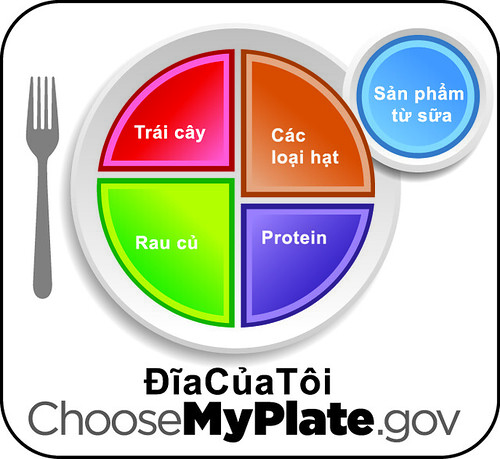

Posted by Elizabeth Rahavi, RD, Nutritionist, on May 28, 2015 at 4:00 PM

The English version of the MyPlate icon was translated into Vietnamese.
As part of Asian American and Pacific Islanders Heritage Month, the Center for Nutrition Policy and Promotion (CNPP) is pleased to announce the translation of the ChooseMyPlate 10 Tips resource and MyPlate icon from English into 18 additional languages. The Office of Minority Health, of the Department of Health and Human Services (OMH/HHS), and CNPP co-branded the translated tip sheet and are working together to promote these newly translated documents to ensure that individuals, nutrition and health professionals, and other community leaders have access to these helpful resources.
“Because the nation’s Asian American and Pacific Islander population is incredibly diverse, the new MyPlate resources will be useful tools to reach an even wider audience with easy-to-understand nutrition guidance,” said Capt. Samuel Wu, Asian American, Native Hawaiian and Pacific Islander Health Policy Lead for the Office of Minority Health.
Dr. Vivian Chen, USDA’s Senior Advisor to the White House Asian American and Pacific Islanders Task Force said, “USDA recognizes how vital it is to reach Limited English Proficient AAPI populations. These translated tip sheets do a great job at reaching many of the AAPI communities needing language access at the local level.”
Asia and the Pacific Islands languages comprise a dozen of the translated versions of the Choose MyPlate Ten Tips: Chinese (Standard), Chinese (Traditional), Korean, Hindi, Indonesian, Japanese, Malaysian, Pashto, Tagalog-Filipino, Thai, Urdu, and Vietnamese. Additional translations also available include: Arabic, French, German, Italian, Portuguese, Russian, and Spanish.
As part of the partnership, OMH will distribute the information to its networks, which includes Regional Minority Health Consultants, State Offices of Minority Health and other offices of minority health within HHS.
CNPP promotion will be through the ChooseMyPlate.gov website and social media accounts, which include more than 75,000 Twitter followers and 50,000 Facebook fans and more than 100,000 individuals who have signed up to receive regular information from MyPlate. CNPP will also be working with communication partners within and outside of the Federal government to raise awareness of these new resources.

The Choose MyPlate Ten Tips translated into Korean is one of 12 Asian American Pacific Island languages that this tip sheet has been translated to.
Related Posts
Tags: AAPI, choosemyplate.gov, CNPP, FNS, Food and Nutrition, HHS, languages, minority health, multi-cultural, MyPlate, OMH, White House
Subscribe to:
Posts (Atom)
